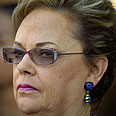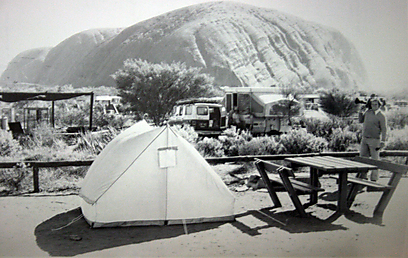
Settling a notorious 1980 case that split the nation and led to a mistaken murder conviction, an Australian coroner ruled Tuesday that a dingo took a baby from a campsite in the Outback, just as her mother said from the beginning.
The eyes of Lindy Chamberlain-Creighton and her ex-husband, Michael Chamberlain, welled with tears as the findings of the fourth inquest into the disappearance of their ninw-week-old daughter, Azaria, were announced in court.
Lindy Chamberlain served more than three years in prison for the baby's death, but was later cleared and has always maintained that a wild dog took her.

Azaria Chamberlain's abduction site (Photo: EPA)
"We're relieved and delighted to come to the end of this saga," a tearful but smiling Chamberlain-Creighton told reporters outside the court in the northern city of Darwin.
Azaria disappeared from a campsite near Ayers Rock, the red monolith in the Australian desert now known by its Aboriginal name Uluru. The case became famous internationally through the 1988 movie "A Cry in the Dark."
Many Australians initially did not believe that a dingo was strong enough to take away the baby. Public opinion swayed harshly against the couple; some even spat on Chamberlain-Creighton and howled like dingoes outside her house.
No similar dingo attack had been documented at the time, but in recent years the wild dogs have been blamed for three fatal attacks on children. Few doubt the couple's story today, but the latest inquest – which the family had fought to get – made it official that Azaria was killed in a dingo attack.
"No longer will Australia be able to say that dingoes are not dangerous and only attack if provoked," Chamberlain-Creighton said before leaving the court with her ex-husband and their three surviving children to collect Azaria's death certificate.
"We live in a beautiful country, but it is dangerous and we would ask all Australians to beware of this and take appropriate precautions," Chamberlain-Creighton said.
4 commissions of inquiry
Coroner Elizabeth Morris said she "satisfied that the evidence is sufficiently adequate, clear, cogent and exact and that the evidence excludes all other reasonable possibilities" than that the baby was taken by one or more dingoes.
The findings mirror those of the first coroner's inquest in 1981, which found that a dingo took Azaria. But that inquest found that somebody had later interfered with Azaria's clothing, which was later found relatively unscathed in the desert.
A second coroner's inquest ended with Chamberlain-Creighton being charged with murder and Michael Chamberlain being charged with being an accessory after the fact. Subsequently, Chamberlain-Creighton was convicted in 1982 and sentenced to life in prison with hard labor.
She was released in 1986 after evidence was found that backed up her version of events. A Royal Commission, the highest form of investigation in Australia, debunked much of the forensic evidence used at trial and her conviction was overturned.
A third inquest could not determine the cause of death.
The fourth inquest heard new evidence of dingo attacks, including three fatal attacks on children since the third inquest.
"This has been a terrifying battle, bitter at times, but now some healing and a chance to put our daughter's spirit to rest," Chamberlain told reporters.
He said his quest for a death certificate that acknowledged his daughter had been killed by a dingo had seemed to be a "mission impossible."
"This battle to get to the legal truth about what caused Azaria's death has taken too long," Chamberlain said.
"However, I am here to tell you that you can get justice even when you think that all is lost. But truth must be on your side."
- Receive Ynetnews updates
directly to your desktop















